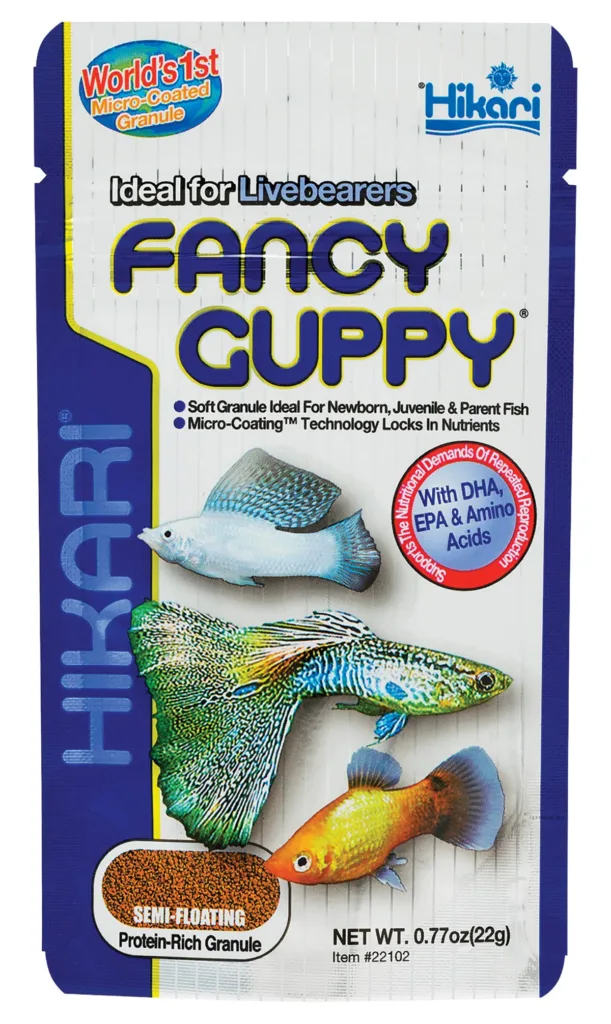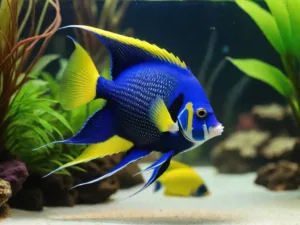Green guppy is a variety of guppy fish that have been selectively bred for their vibrant green coloration. They can be found in a wide range of shades, from light lime green to deep emerald green. Some green guppies also have other colors and patterns, such as yellow, orange, blue, or black. In this comprehensive care guide, we will delve into everything you need to know about the green guppy – its appearance, origin, tank setup, breeding, feeding, common diseases, and more.
What are Green Guppies
Green guppies are a type of guppy fish that has been selectively bred to have a green coloration. They can be solid green, or they can have green markings on their bodies, fins, or tails. Green guppies are available in a variety of different breeds, including the Green Cobra Guppy, the Green Moscow Guppy, and the Green Emerald Guppy.
Appearance of Green Guppies
- Male Green Guppies: Male green guppies typically exhibit more vibrant and extensive green coloration than females. Their bodies are slender, and their fins are often elaborately adorned, with dorsal and caudal fins being more developed. A male’s tail fin may have a distinct pattern of spots or stripes. They are generally smaller, ranging from 1.2 to 2 inches (3-5 cm) in length.
- Female Green Guppies: Female green guppies, in contrast, are less flamboyant in color but have a larger, more robust appearance. Their green hues are comparatively subtle, and they possess a gravid spot near their anal fin, which becomes more pronounced when they are pregnant. Females are slightly larger, typically measuring between 2 to 2.4 inches (5-6 cm) long.
Please note: The distinctive green coloration in both male and female green guppies may vary slightly depending on their lineage and specific breeding conditions.

Origin
The green guppy’s origin can be traced back to selective breeding practices within the guppy community. Breeders have meticulously selected and bred guppies with green color variations to enhance and stabilize the green pigment. This intentional breeding has led to the development of the green guppy as a distinct variety that is widely available in the aquarium trade.
Tank Setup
Creating an optimal habitat for green guppies is crucial to their well-being and overall health. Here’s a detailed guide to setting up the perfect tank:
Tank Size
- A tank with a capacity of 10 gallons (approximately 38 liters) or larger is recommended for a small group of green guppies. Guppies are social creatures, so keeping them in groups of at least three is ideal.
Water Parameters
- Temperature: Maintain a water temperature in the range of 72-82°F (22-28°C). Ensure a reliable aquarium heater to prevent temperature fluctuations.
- pH Level: Aim for a slightly alkaline pH level of around 7.0-7.5, which mimics their natural habitat.
- Water Hardness: Green guppies thrive in moderately hard water with a dGH (degree of general hardness) of 10-15.
Filtration and Aeration
- Install a suitable aquarium filter to maintain water quality. Guppies are sensitive to ammonia and nitrite, so efficient filtration is essential. Additionally, an air pump or a sponge filter can provide necessary aeration.
Decor and Substrate
- Guppies enjoy a well-decorated tank with live or artificial plants, driftwood, and hiding spots. Fine gravel or sand can be used as a substrate.
Lighting
- Provide moderate lighting to mimic their natural environment. A timer can help maintain a consistent light cycle.
Maintenance
- Regular water changes of 10-20% every 1-2 weeks are vital to keep the water clean and healthy for your green guppies.
Please Note: It’s essential to cycle your tank before introducing green guppies, as it establishes a stable environment by breaking down harmful ammonia and nitrite compounds.
Breeding Green Guppies

One of the most exciting aspects of keeping green guppies is their ease of breeding. These fish are prolific breeders, and it can be a rewarding experience to witness the birth of their fry. Here’s how to breed green guppies successfully:
Breeding Tank Setup
- Set up a separate breeding tank, or use a breeding box within your main aquarium to protect the fry from potential predators.
- Ensure the breeding tank has suitable hiding places, such as fine-leaved plants or breeding traps, to keep the female and her fry safe.
Pair Selection
- Select a healthy male and female guppy for breeding. Females are ready to breed when they exhibit a prominent gravid spot, which darkens as they approach giving birth.
Breeding Process
- Introduce the chosen pair into the breeding tank or breeding box. The female will give birth to live fry, which can number anywhere from 20 to 60 or more.
- Remove the adult guppies once the fry are born to prevent them from consuming their own offspring.
Feeding Fry
- Fry can be fed with powdered fry food or crushed flake food until they are large enough to consume regular guppy food.
- Maintain clean water and monitor water parameters carefully to ensure the fry’s well-being.
Green guppies are excellent choices for novice breeders, as they typically require minimal intervention to successfully breed and raise their fry.
Feeding Green Guppies

Proper nutrition is essential to maintain the health and vibrancy of your green guppies. Here’s what you need to know about their dietary requirements:
Diet for Adult Green Guppies
- High-Quality Flake Food: A staple of a guppy’s diet, high-quality flake food specially formulated for tropical fish provides essential nutrients. Look for flake food that contains a balanced blend of proteins, fats, and carbohydrates.
- Live and Frozen Foods: Supplement their diet with live or frozen foods like brine shrimp, daphnia, and bloodworms. These protein-rich treats can enhance their coloration and overall health.
- Vegetables: Occasionally offer blanched vegetables like spinach, zucchini, or peas. These provide fiber and variety to their diet.
- Feed Sparingly: Avoid overfeeding, as guppies are prone to overeat. Feed small portions several times a day, and ensure they consume their food within a few minutes.
Diet for Green Guppy Fry
- Newly born fry can be fed powdered fry food or liquid fry food until they are large enough to consume regular flake food. Ensure that the food particles are small enough for their tiny mouths.
- Frequent, small feedings are crucial for the growth and development of fry. You can feed them multiple times a day.
Remember to observe your guppies and adjust their diet as needed. Overfeeding and underfeeding can both lead to health issues.
Common Diseases in Green Guppies
While green guppies are generally hardy, they are not immune to common fish diseases. Being aware of these illnesses and their symptoms can help you prevent and treat them effectively:
1. Ich (White Spot Disease)
- Symptoms: White cysts resembling grains of salt on the fish’s body and fins, flashing (rubbing against objects), and rapid gill movement.
- Treatment: Raise the tank temperature to 86°F (30°C) gradually and administer an ich treatment.
2. Fin Rot
- Symptoms: Tattered or eroded fins, discolored and frayed edges, behavioral changes.
- Treatment: Isolate the affected fish, improve water quality, and administer antibiotics as directed.
3. Dropsy
- Symptoms: Swollen, pinecone-like scales, bulging eyes, loss of appetite, and lethargy.
- Treatment: Isolate the infected fish and maintain pristine water conditions. Epsom salt baths can help alleviate swelling.
4. Velvet (Gold Dust Disease)
- Symptoms: Fine, dust-like gold or gray cysts on the skin and gills, lethargy, clamped fins.
- Treatment: Raise the tank temperature to 82-86°F (28-30°C), and use a copper-based medication.
5. Columnaris (Mouth Fungus)
- Symptoms: White, cotton-like growth around the mouth and on the body, lethargy, loss of appetite.
- Treatment: Isolate the affected fish and treat with an antibiotic medication.
6. Parasitic Infections
- Symptoms: Behavioral changes, scratching against objects, visible parasites on the skin or gills.
- Treatment: Identify the specific parasite and administer the appropriate treatment, which may include antiparasitic medications.
Regular observation, proper nutrition, and maintaining a clean environment are crucial for preventing diseases in green guppies. Quarantining new fish before adding them to your established tank can also help prevent the introduction of diseases.
Where to Buy Green Guppies?
There are a few different places where you can buy green guppies:
- Pet stores: Most pet stores sell green guppies, although the variety and quality may vary. Be sure to inspect the fish carefully before you buy them to make sure they are healthy and active.
- Online retailers: There are also a number of online retailers that sell green guppies. This can be a good option if you are looking for a specific breed or color of green guppy. However, be sure to do your research to make sure you are buying from a reputable retailer.
- Local fish breeders: Another option is to buy green guppies from a local fish breeder. This can be a good way to get high-quality fish that have been bred in a healthy environment. You can find local fish breeders by searching online or asking at your local pet store.
Here are some tips for buying green guppies:
- Inspect the fish carefully before you buy them. Look for fish that are active and have no signs of disease or injury.
- Ask the seller about the fish’s diet and care requirements. Make sure you are prepared to provide the fish with the proper care.
- If you are buying from an online retailer, be sure to read reviews of the retailer before you buy. This can help you avoid buying from a disreputable retailer.
Once you have purchased your green guppies, be sure to quarantine them for two weeks before adding them to your main aquarium. This will help to prevent the spread of any diseases to your other fish.
How Much Do green guppies cost?
The cost of green guppies can vary depending on a number of factors, including the breed, color, and size of the fish, as well as where you purchase them from. However, in general, green guppies are relatively inexpensive fish.
Most green guppies can be purchased for between $2 and $10 per fish. However, some rarer or more sought-after breeds, such as the Green Moscow Guppy, may cost more than $25 per fish or $50 for a breeding pair.
Here are some tips for saving money on green guppies:
- Buy from a local fish breeder. Local fish breeders often sell their fish at lower prices than pet stores or online retailers.
- Buy in bulk. If you are buying multiple green guppies, you may be able to get a discount from the seller.
- Look for sales and promotions. Many pet stores and online retailers offer sales and promotions on green guppies, especially during certain times of the year.
With a little planning, you can easily find green guppies at a reasonable price.
Conclusion
Green guppies are not only visually captivating but also relatively easy to care for, making them an excellent choice for both beginner and experienced aquarium enthusiasts. By understanding their unique characteristics, providing an appropriate tank setup, and following proper care and maintenance, you can enjoy the beauty and charm of green guppies in your home aquarium. Remember to feed them a balanced diet, monitor their health, and take prompt action if any signs of disease appear. With the right care, your green guppies will thrive and bring joy to your aquatic world.










